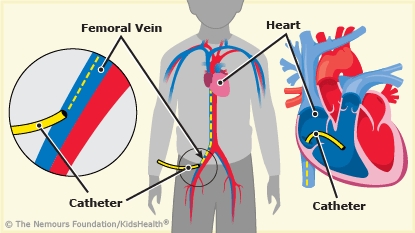How to Care for Your Child After Cardiac Catheterization
A cardiac catheterization is a procedure that cardiologists (heart doctors) do to diagnose and treat heart problems. After cardiac catheterization, most kids are ready to go back to their regular activities within about a week. Use these instructions to care for your child during that time.


Follow the cardiologist's instructions for:
-
when it's OK for your child to drink and eat. Start with clear fluids like water and apple juice and then slowly let your child eat regular food.
-
giving pain medicines
-
continuing medicines your child was on before the procedure or starting new ones
-
when to remove the bandage
-
if you need to stop the car on the ride home so your child can get up and walk around
-
when your child can bathe
-
when your child can return to regular activities, school, and sports
Take the bandage off as instructed by the cardiologist, usually the day after the catheterization:
-
Wet the sticky parts of the bandage to help it come off. Take the bandage off, then dry the area and put a small adhesive bandage (Band-Aid® or a store brand) over the area where the catheter went in.
-
Gently wash the area where the catheter went in with soap and water at least once a day. Then, cover it with a new adhesive bandage.
-
For about 2–3 days, don't let the area where the catheter went in get too wet. Have your child:
-
Take sponge baths or short showers.
-
Avoid baths, hot tubs, and swimming.


What happens during a cardiac catheterization? During a cardiac catheterization, the cardiologist inserts a catheter (a long, thin tube) into a blood vessel. Then, they guide it to the heart and the blood vessels around the heart and do the test or procedure.
Why are cardiac catheterizations done? Cardiac catheterizations can help cardiologists diagnose and treat many different heart problems. They might do the procedure on kids or teens to:
-
Look at how the heart and blood vessels are formed and connected.
-
Check the pressures and oxygen levels in the heart and blood vessels.
-
Treat a congenital heart defect (a heart problem that a baby is born with).
-
Treat an irregular heartbeat (arrhythmia).
-
Open narrowed blood vessels (an angioplasty).
-
Repair leaky or narrow heart valves.